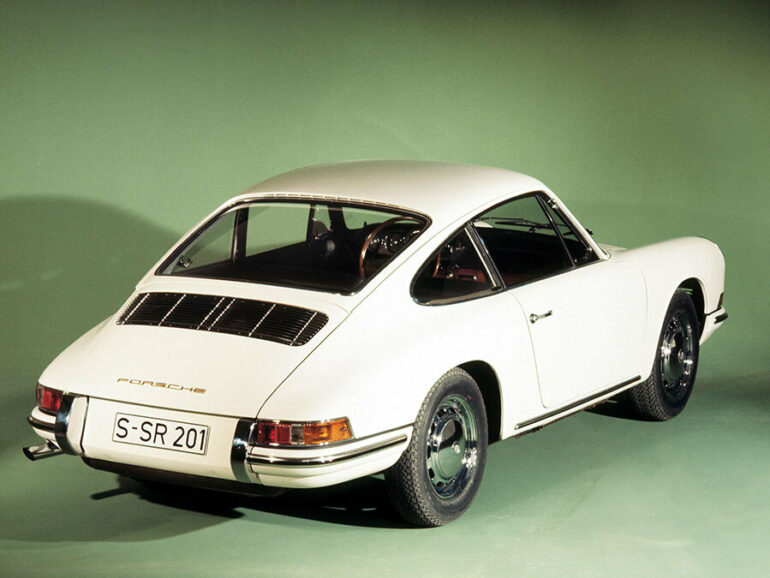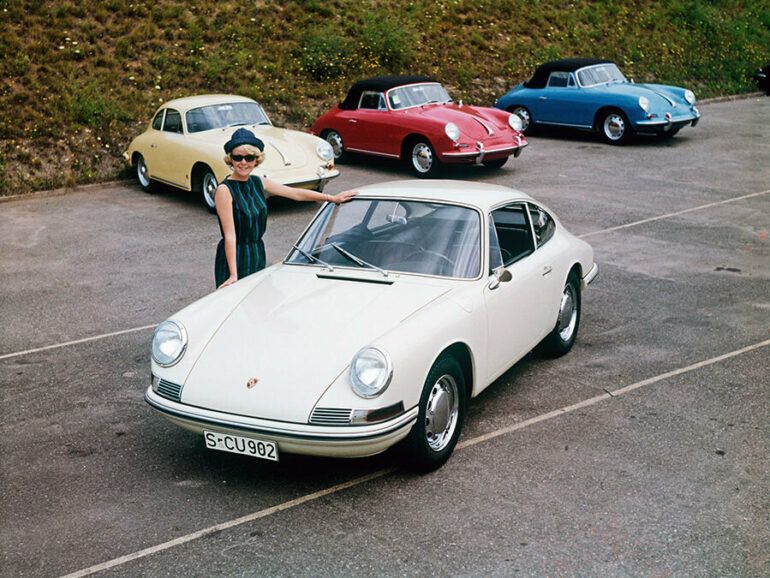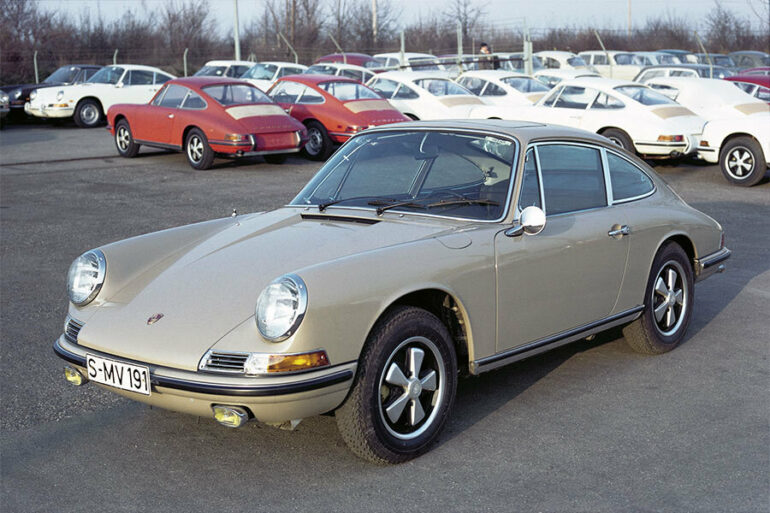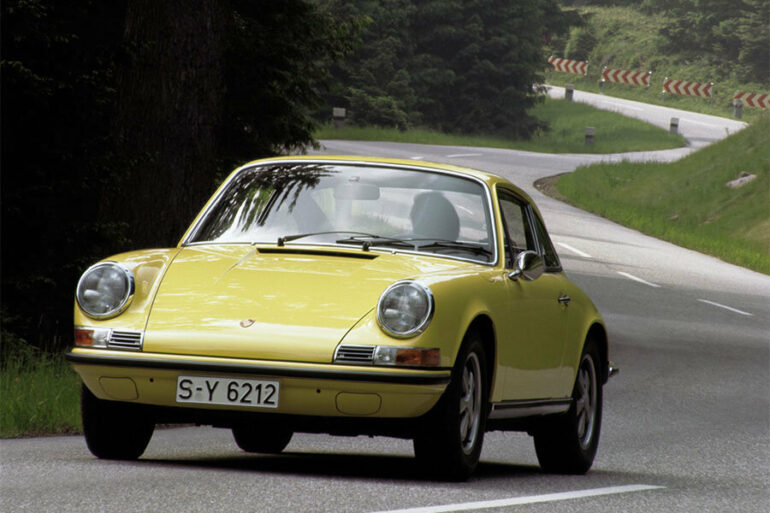Porsche 911 (F-Series) – The Story
The Original. The Porsche 911.
The Story / Timeline / Details / Model Guides / Performance & Specs / Data & Research / Pictures & Videos / News & Updates
The Porsche 911 was introduced to the world in the fall of 1963 at the Frankfurt Motor Show. It was developed as a replacement for the highly successful Porsche Model 356. It was larger, more powerful, more comfortable and more competitive on the track than any other comparable car on the market at the time. The original air-cooled, boxer-engined 911 was in production from 1964 through 1989, but on this page, we are focused on the original F-Body cars. Info on the G-Body cars is found here.
We all know the 901 story don't we? A prototype of the 901, as it was called for a brief period, was unveiled at the Frankfurt Motor Show. Production slowly started in September 1964 and the 901 was shown at the October 1964 Paris Motor Show, barely one month after the start of production. Peugeot objected to the model number, saying that it had the rights to three-digit model numbers with a zero as the middle digit. Although this would only apply to sales in France, Porsche decided to just add a “1,” creating the 911. There were about 80 cars built and labeled 901 before the change.
It was decided to use the lower-cost 356 engine in the new 911 body and call the resulting model the 912. This was successful to the point that the 912 outsold the 911 two to one for a couple years. The last year for the 912 in this form was 1969. The first edition of the 911 was built around a 130 hp, 2.0 liter, flat-six, air-cooled, rear-mounted engine. In 1966 the beefier 160hp 911S was introduced as the first variation of the 911. The "S" which stood for "Super" boasted performance upgrades and modifications that included larger valves, a higher compression ratio, better porting and larger carbuerator jets. Along with the mechanical tweaks, the 911S also received chassis upgrades in the form of a rear anti-roll bar, Koni shocks, distinctive 5-spoke Fuchs alloy wheels and ventilated disc brakes. This really marked the beginning of the 911 as a genuine performance car. This was also the first year for the Targa.
For 1969 Porsche made the single biggest change to the 911 thus far by lengthening the wheelbase 2.5 inches to reduce the oversteer characteristics inherent to rear-engined cars. Pre-1969 cars are often referred to as the short-wheel base cars (SWB) and 1969 onwards called the long-wheelbase cars (LWB). In LWB cars, two 12-volt batteries were installed in each front corner in a further attempt to improve the handling, instead of the earlier bumper-weight solution. They also expanded the model range to three versions, which now included T, E, and S. The E and S got a new induction system in the form of mechanical fuel injection (MFI) to meet emission standard. The next two years, 1970 and 1971, can almost be taken as one step, since there were almost no differences in that time frame. The three model variants, T, E, and S, remained, but the 912 was dropped. Engine displacement was increased to 2.2 liters, the E and S retained mechanical fuel injection, and the T still met emissions with carburetors.
1972 and 1973 can also be taken as one group because there were very few changes from year to year. 1973 marked the end of the longhood 911, when, in 1974, the design of the original body style was changed in order to meet new bumper crash standards. The 1972 and 1973 engine displacement was increased again to 2.4 liters to gain back some power lost from compression ratio reductions to meet the new lower-octane lead-free fuel.. The Type 915 transmission was a totally new design. It was stronger and had a more user friendly H pattern for the first four gears, instead of the old dog-leg first gear that was down and to the left. 1972 was also the first and only time to date where the oil tank was mounted ahead of the right-rear wheel (other than the few 911Rs in 1967 and 1968) for weight distribution reasons.
We can't talk about the classic 911 without mentioning the most famous 911 of all. The 1973 911 Carrera RS was built largely to homologate the faster 911 RSR race car for GT racing and it may be the purest 911 ever made. It is still the GOAT.
Generation: First Generation / Known As: F-Body or Classic 911 / Manufacturer: Porsche AG / Production Years: 1964 - 1974 / Model Years: 1964 - 1974 / Designer: Ferdinand Alexander Porsche, Erwin Komenda / Body Style: 2-door coupe, 2-door targa / Layout: Rear-engine, rear-wheel drive / Engines: 1.6 L Aircooled Flat 4 (912), 2.0 L Aircooled Flat 6, 2.2 L Aircooled Flat 6, 2.4 L Aircooled Flat 6, 2.5L Aircooled Flat 6, 2.7 L Aircooled Flat 6, 2.8 L Aircooled Flat 6 / Transmission: 4-speed manual, 5-speed manual, 4-speed automatic / Premiere: September 12, 1973 IAA Frankfurt / Successor: Porsche 911 (G-Body)
This graphic breaks out the first generation Porsche 911 in terms of timelines and how to tell all the models apart. Click on the image to see it in higher definition. We split the timeline into entry level, standard level and sports-focused cars to make life easier visually.
The original 911 had a steel bodyshell that was 111 mm longer than the outgoing 356, giving the 911 a roomier cockpit and better handling. The suspension layout was MacPherson struts at the front with a fully independent back end was much more advanced than the 356 set up. The 911’s air-cooled all-alloy Flat 6 engine was the Type 901/01 and had dry-sump lubrication, overhead camshafts, hemispherical cylinder heads and a forged seven main bearing crankshaft. The new engine had a displacement of 1991 cc, with a 9.1:1 compression ratio and two triple-choke 40PI Solex carburettors. Peak output was 130 bhp at 6100 rpm. The transmission was a new Type 901 five-speed gearbox.
The design was the work of Ferdinand ‘Butzi’ Porsche and it clearly evolved from the 356 and it was initially available as a Coupe. Porsche quoted a weight of 1030 kg, a top speed of 131 mph and 0-60 mph time of 8.3 seconds. Production began in August 1964. April 1965 saw production of the Porsche 912 begin. Powered by the four cylinder 356 engine, it was conceived as an entry-level 911 and initially outsold the considerably more expensive six cylinder variant. The Targa was introduced in late 1966 and a 1967 model year.
In July 1966, Porsche unveiled an uprated 911 S model. It had a Type 901/02 engine with upgrades including bigger intake and exhaust valves plus hardened connecting rods and forged pistons. Compression was increased from 9.1 to 9.8:1 and two Weber 40 IDS carburetors were installed along with a more efficient gas-flowed three-to-one exhaust system. Power was 160 bhp at 6600 rpm. The 911 S also got Koni shocks as standard and a bigger front anti-roll bar. Ventilated disc brakes were fitted for the first time.
The O-series 911s were produced between August 1964 and July 1967 and during this time, 8520 standard Coupes were built and 3422 911 S Coupes. 718 911 Targas were also built, a figure that included both S and non-S variants. In August 1967, the O-series 911 was replaced by the A-series derivative.




In 1967, the original 911 was replaced by the A-series. The 1968 model year A-series 911 was available in four basic varieties: the 911 T, the ‘normal’ 911, the 911 L and the 911 S. All four could be ordered with Coupe or Targa bodywork and with either a manual or semi-auto gearbox. The chassis and suspension was unchanged. The 911 did get a new brake system, dry-sumped engines with single overhead cams and a new Sportomatic transmission option.
Changes on the outside were subtle and came in the form of changed wipers, door handles changes to the cooling slats on the engine cover. US destined cars came with bumper overriders and thicker headlight shrouds.
The A-series 911 was discontinued in August 1968 to make way for the 1969 model year B-series change. B-series 911s got a 57mm longer wheelbase and larger rear brakes. Wheelarches got a subtle flare design and the indicators were a bit bigger too.
Porsche dropped the ‘normal’ 911 and 911 L in favor of a new mid-range model called the 911 E. The 911 E got Bosch mechanical fuel-injection and ignition, thus making them eligible to be sold in North America. The new Type 901/10 engine in the fuel-injected 911 S was further uprated with bigger intake and exhaust valves and a lightweight magnesium engine casing.
B-Series production stopped in July 1969 to make way for the C-series 1970 model year 911 which came with a bigger 2.2-litre engine.
The 2.2 liter 911s arrived for the 1970 and 1971 model years, available once again as either Coupe or Targa and with three engine tunes. The 125 bhp 911 T, the 155 bhp 911 E and the 180 bhp 911 S. The engines were bored out to 84mm and the engines got larger valves, new head gaskets and more cooling fins. The 911 E had softer cams to make it less spikey to drive on throttle, while the 911 S got a 10 bhp bump in power. The 911 E and 911 S got five-speed gearbox while the 911 T had only four-speeds.
The front suspension mounting points were moved 14 mm forward which increase wheelebase and made steering better at slow speeds. The E kept its hydro-pneumatic struts. Ventilated disc brakes were now fitted across the entire range, a big improvement. Also standard were 6 x 15-inch Fuchs forged alloy wheels. Cosmetically, no major changes were made.
C-series production started in August 1969 and continued until July 1970. The 1971 model year D-series 911 were next up, with several upgrades. The body was now galvanized and squirters were introduced to improve piston cooling. There was also a new type of sealed chain tensioner while minor detail alterations were made to the fuel-injection system. D-series production ended in August 1971 to make way for the new 2.4-litre E-series variant.




In September 1971, Porsche unveiled the 2.4-litre E-series 911s. These 2.4-litre cars were 1972 and 1973 model year cars. They were offered in three states of tune (911 T, 911 E and 911 S.) and two alternative body styles (Coupe and Targa).
The wheelbase was extended by 3mm thanks to rear suspension mounting points being moved, making the 911 a bit more luxurious to drive and less punishing day to day. The gearbox had a conventional gate pattern.
The engines featured new camshafts, shorter and lighter con rods, reduced height piston crowns cooled by individual oil jet sprays, improved porting, larger big ends, full crankshaft counter-balancing, a crankcase stiffened around the main bearings and a new forged crankshaft.
Production began in August 1971. Porsche’s 1973 model F-series 911s were produced from August 1972 and came with more upgrades.
North American cars got black rubber overrider pads and in January 1973, the fuel-injected US-spec 911 T switched to a Bosch K-Jetronic Injection System and new camshafts were fitted. Production of the F-series 911 continued until July 1973.
1st Gen Porsche 911 Special & Motorsport Models
There were several motorsport and special edition 911s in the first generation. The 911R was a very limited production racing version of the 911 whose concept would ultimately set the standard for GT racing domination for the next 40 years. The first 4 prototypes surfaced in the spring of 1967. Most famously, the Carrera RS debuted in October 1972 at the Paris Motor Show, and was the top first generation 911 and one of the best road cars of all time. It was the fastest production 911 and a solid race winner. Some feel it is still the best 911 ever built. But it wasn't the only special first generation 911, so make sure to check them all out.
Porsche 911 (1964-1974) Technical Specs
Forget the summary, here is every first generation Porsche 911 broken out by model year and variant and the technical specifications for each one. Car data nerds, let us unite.
Porsche 911 (1st Generation) News & Updates
Recent auctions, awesome review videos and all the latest news and posts regarding anything to do with the first generation, F-bodied Porsche 911.
Join Our Porsche Community
Sign up for our weekly Porsche newsletter. The latest Porsche news, rumors, reviews and more delivered to your inbox. Cool Porsche stuff perfect for the flat-six obsessed.